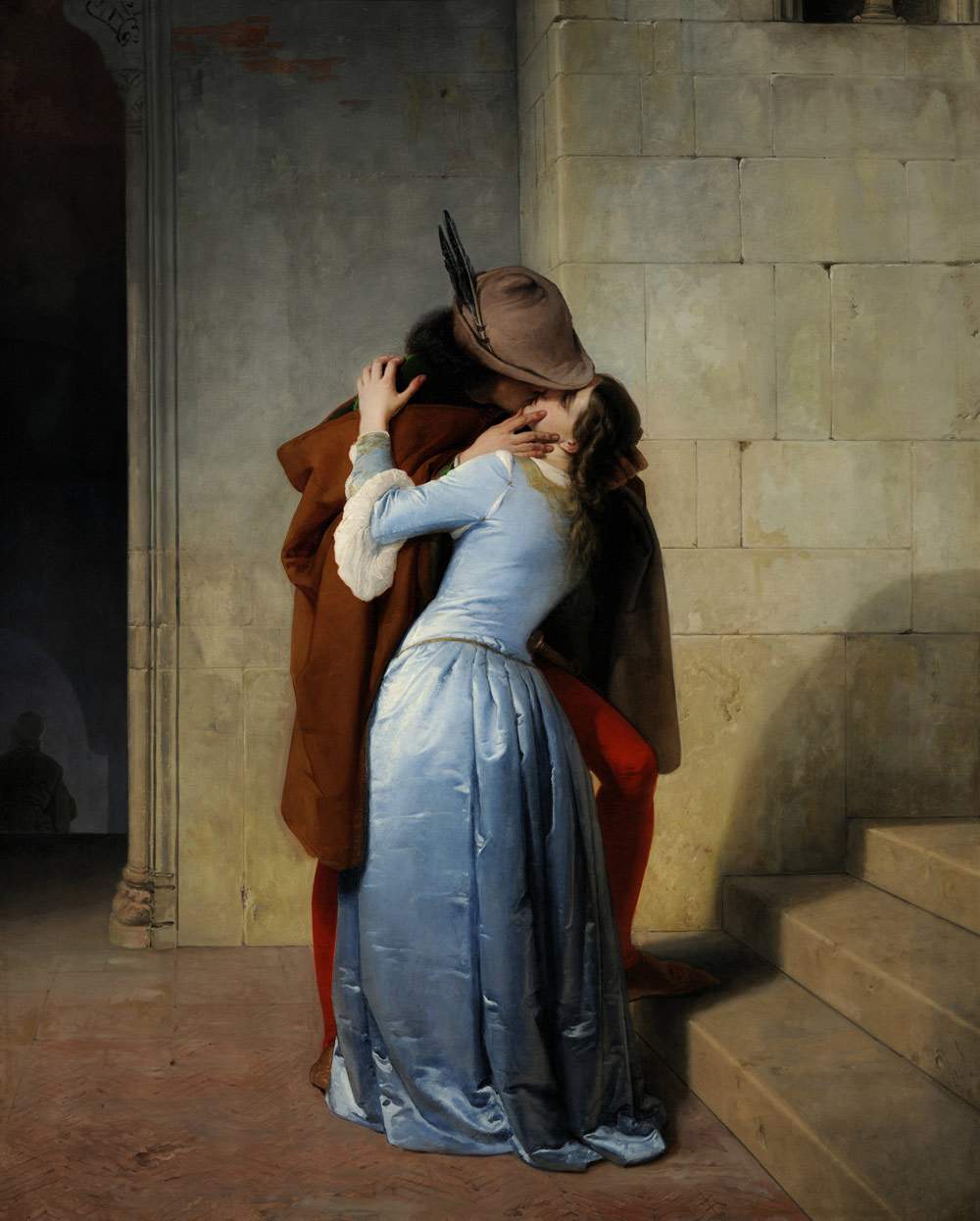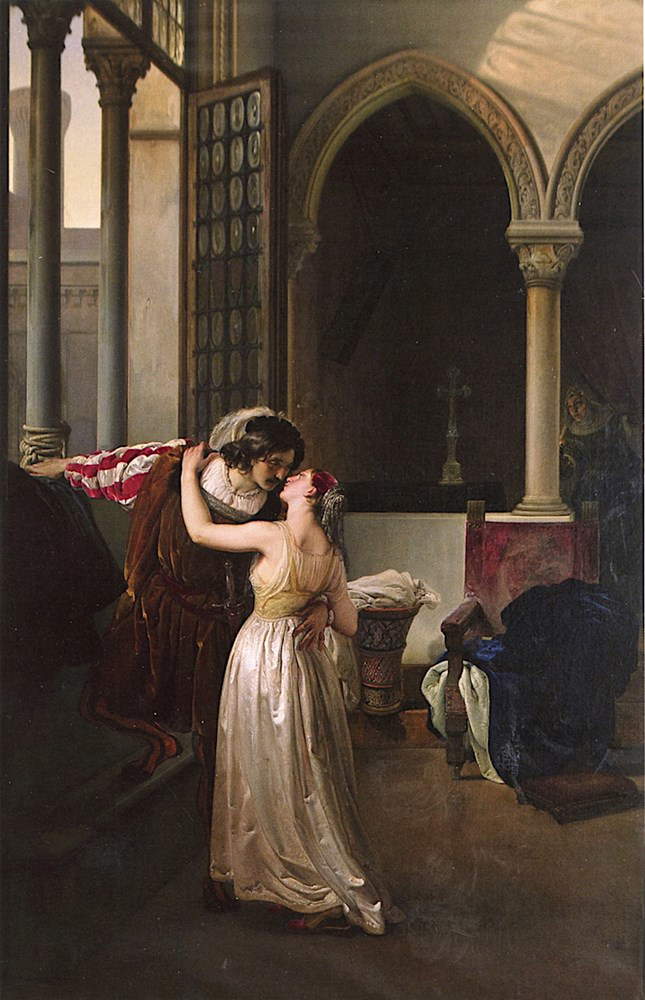The kiss between two lovers was for Francesco Hayez (Venice, 1791 - Milan, 1882) one of his most depicted subjects: Indeed, very famous is the Kiss preserved in the Pinacoteca di Brera, which the painter painted in 1859 on a commission from Count Alfonso Maria Visconti di Saliceto, of which there are two other, later versions (one from 1861 and the other from 1867, both in private collections), but years earlier the artist had already dealt with this subject.... romantic. In fact, theLast Kiss between Romeo and Juliet, now preserved at Villa Carlotta in Tremezzo on Lake Como, dates from 1823.
The Venetian Hayez had moved permanently to Milan, following his obtaining the adjunct professorship at the Brera Academy, but he had already begun frequenting the Lombard city in 1820 and it was during his Milan sojourns that he had occasion to meet the well-known writer Alessandro Manzoni, with whom he became good friends, so much so that 20 years later he depicted him in one of the most iconic paintings of his vast output.
Considered the greatest exponent in Italy of Romanticism, a movement that developed in Europe between the late eighteenth and mid-nineteenth centuries in opposition to the Enlightenment, Francesco Hayez began to approach this movement in 1820 with the painting Pietro Rossi at Pontremoli, which was presented at the Brera Academy exhibition with the long descriptive title Pietro Rossi, lord of Parma, stripped of his domains by the Scaligeri, lords of Verona, while being invited to the Castle of Pontremoli, of which he was defending, to take command of the Venetian army, which was to move against his own enemies, he is tearfully beseeched by his wife and two daughters not to accept the undertaking. The episode depicted, recounted in Marc-Antoine Laugier’s 1758Histoire de la République de Venise , was taken from a story that actually happened in the 15th century, and Hayez makes the sentiments that came into play in that event clearly visible here: the pride of Pietro Rossi and the prayers of his wife and two daughters kneeling on the ground to try to persuade him not to leave. Unlike his early neoclassical paintings, the style resulting from Enlightenment culture that was based on rational ideals, the artist in Pietro Rossi in Pontremoli began to emphasize feelings and the manifestation of affections in a medieval, not classical, setting . In fact, Romanticism was based primarily on the exaltation of emotion over reason and intellect, the triumph of states of mind, and an interest in popular culture and medieval times.

Elements that are all also present in TheLast Kiss between Romeo and Juliet, the first painting with which the artist confronts an important literary theme inspired by the sixteenth-century novella History of Two Noble Lovers by Luigi Da Porto and , above all, by an important literary work such as the tragedy of Romeo and Juliet as told by William Shakespeare. Indeed, the playwright is said to have been inspired for the story of the two ill-fated young men of Verona by Luigi Da Porto’s novella, or rather, according to studies of the work, by Matteo Bandello’s version of Romeo and Juliet, La sfortunata morte di dui infelicissimi amanti, which in turn was inspired by Da Porto.
Shakespeare tells how, after killing Tybalt, Juliet’s cousin, Romeo is condemned by the Prince to exile, and how he is in despair for this reason. Friar Lorenzo tries to comfort him, who schemes to send him to Mantua until he obtains, through his intercession, the Prince’s pardon. Juliet’s nurse also comes to them, who tells how the young woman is also in despair over what has happened, shedding tears of weeping for Romeo who “is for her a stroke of lightning that kills her,” and for Tybalt whom “Romeo’s hand killed.” The friar suggests that Romeo cautiously go to his beloved to console her, and recommends that the nurse warn Juliet of his coming, so that she may send her own to rest at an early hour. Romeo, however, must leave the city before the sentries are posted or at the latest at dawn in disguise.Scene V of Act III is thus set in Juliet’s room and dawn is coming. At first the maiden believes that the first light of morning has not yet arrived (“That light is not dawn, I am sure, I. It is a meteor, emanating from the sun to light your way and escort you, tonight, like a servant with a flashlight, to Mantua. That is why you can still stay: there is no need for you to leave.”), but then she realizes that it is really daylight and then urges Romeo to hurry away. At that moment the nurse enters, warning that Juliet’s mother is about to arrive in the room. At that point, going to the verandah, Romeo says, “Farewell, farewell; one more kiss, then I’ll come down,” and descends by the ropes that hung from the verandah.
This is exactly the scene that Hayez depicts in his Last Kiss. The two protagonists are in a medieval-style domestic setting, enhanced by columns with decorated capitals and arches, large polychrome stained glass windows, and on a small wall a devotional painting above a crucifix. In the half-light we catch a glimpse of Juliet’s nurse, who entered the room with a candle in her hand to warn that her mother would soon be arriving. Through the open window, from which a tower can be seen, the first morning lights enter and begin to brighten the architectural elements and especially the two young people,locked in a sweet and tender embrace. Romeo in medieval clothing with feather on his hair already has one foot on the step; with one hand he clutches Juliet to him and with the other he has already grasped the rope ready to run away. Juliet in a damask robe and chamber slippers (other clothes can be seen resting informally on a chair behind her) lifts her arm to rest her hand gently on her beloved’s shoulder and indulges in a kiss, her eyes half-closed. And to reach his height, she rises slightly on her toes. A passionate but fleeting kiss, for the day is now upon us.



As art historian Fernando Mazzocca, one of the foremost experts on Francesco Hayez’s painting, wrote in the catalog of the major exhibition on Romanticism curated by him and held at the Gallerie d’Italia in Piazza Scala between 2018 and 2019, on the occasion of which the work was transferred from Tremezzo to Milan, “everyone admired different elements in it, such as the evocative and faithful reconstruction of theenvironment, a sensuality reminiscent of Titian, or the sumptuous rendering of the costumes, such as the ’maiden’s dress, whose luster imitates the finest velvet of France.’” He goes on to point out that it was Defendente Sacchi, the leader of Romantic criticism, who had “seen in it a sort of manifesto, since ’his Juliet is certainly not Venus and is not the ancient woman [...] she is beautiful, but beautiful of her love,’ while ’Romeo is not the Antinous, nor the Apollo, yet he is with desire regarded by the feminine curiosity and announces to you the flower of ’valiant and lovers.’” Finally Mazzocca concludes by saying that it was Ludwig Schorn, the German correspondent of Kunst-Blatt in Milan, who was first impressed by the work at the exhibition, thus opening the debate, denouncing the excessive truth of that “kiss” which “is not the tender love of a pure enchanted soul,” but “is voluptuous.”
Exhibited at the annual Brera Fine Arts exhibition in 1823, the work was commissioned by Count Giovan Battista Sommariva, one of the best-known collectors of the time (Hayez would later replicate the work in other variations, given its success). If until then Sommariva had focused on paintings of neoclassical taste, with Hayez’sLast Kiss between Romeo and Juliet his collection opened up to Romantic art. The novelty of the theme and the new way of representing feelings made the painting a great success, in part because of the artist’s ability to combine Venetian-style chromaticism with a meticulous rendering of the details of the domestic and architectural environment.

Thanks to investigations in which reflectography and false-color infrared were used, carried out in 2015 by the Department of Science and High Technology of the University of Insubria, it was possible to ascertain the presence of the author’s rethinking during the painting’s creative process, both in the characters and in the architectural elements: for example, Juliet’s reworked profile, the neck of Romeo’s robe originally higher, the young man’s left foot originally shorter and later lengthened, rethinking in the geometry of the decorative motifs of the stained glass windows, the presence of a second row of battlements. It was also possible to identify which pigments were used by the artist, such as Prussian blue in the mantle resting on the chair, already used in other paintings as well, cinnabar red in Romeo’s pants and Juliet’s slippers, and probably the use of lapis lazuli, cobalt blue or cerulean blue in the stained glass windows.
If the story of Romeo and Juliet was made famous in the literary sphere by William Shakespeare and is still considered one of the greatest and most eternal love stories in literature, nonetheless Francesco Hayez also contributed to its dissemination in the artistic sphere: in fact, after 1823, he reprised their story in three more paintings, in 1825 and twice in 1830, all in private collections. The greatest interpreter of Italian Romanticism depicted in the Villa Carlotta painting their last kiss. A goodbye kiss that neither of the two young lovers imagined would actually be a farewell kiss.
Warning: the translation into English of the original Italian article was created using automatic tools. We undertake to review all articles, but we do not guarantee the total absence of inaccuracies in the translation due to the program. You can find the original by clicking on the ITA button. If you find any mistake,please contact us.